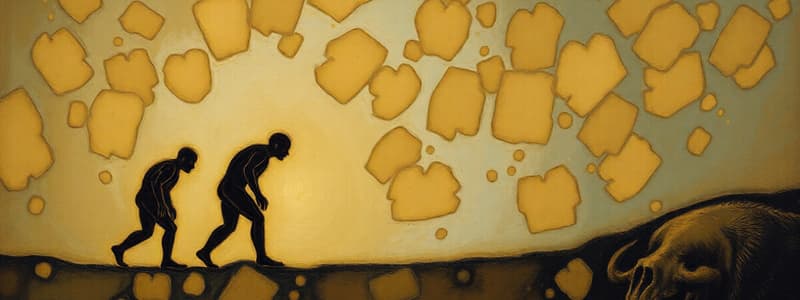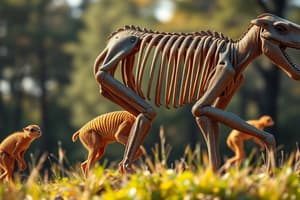Podcast
Questions and Answers
What is defined as the cumulative change in a population of organisms over time?
What is defined as the cumulative change in a population of organisms over time?
Evolution
What is the name of Charles Darwin's book on the theory of evolution?
What is the name of Charles Darwin's book on the theory of evolution?
On the Origin of Species by Means of Natural Selection
Which of the following is NOT considered evidence of evolution?
Which of the following is NOT considered evidence of evolution?
- Geographic Distribution
- Fossil Records
- Astrology (correct)
- Comparative Anatomy
Fossil records provide concrete evidence of what organisms looked like and how they lived.
Fossil records provide concrete evidence of what organisms looked like and how they lived.
Geographic distribution can reveal how organisms evolved in their natural environments.
Geographic distribution can reveal how organisms evolved in their natural environments.
Comparative anatomy focuses on the study of similarities and differences in the structures of different species.
Comparative anatomy focuses on the study of similarities and differences in the structures of different species.
The similarity in embryonic development of vertebrates, including fishes, birds, and amphibians, can help explain the resemblance of these groups in terms of shared ancestry.
The similarity in embryonic development of vertebrates, including fishes, birds, and amphibians, can help explain the resemblance of these groups in terms of shared ancestry.
Genetic changes, such as differences in DNA sequences, can provide evidence of evolutionary relationships.
Genetic changes, such as differences in DNA sequences, can provide evidence of evolutionary relationships.
What is the process called when closely related species diverge to new habitats and lifestyles?
What is the process called when closely related species diverge to new habitats and lifestyles?
What is the process called when distantly related lineages evolve similar structures due to adaptations to similar habitats?
What is the process called when distantly related lineages evolve similar structures due to adaptations to similar habitats?
What is the process called when an ancestral species invades a new territory and occupies diverse niches?
What is the process called when an ancestral species invades a new territory and occupies diverse niches?
What is the process called when two or more species affect each other's survival and evolution?
What is the process called when two or more species affect each other's survival and evolution?
Which of the following describes the pace of evolution as continuous change at a constant rate?
Which of the following describes the pace of evolution as continuous change at a constant rate?
Which of the following describes the pace of evolution as short bursts of change followed by periods of stability?
Which of the following describes the pace of evolution as short bursts of change followed by periods of stability?
Phylogenetic systematics is the field of biology that deals with identifying evolutionary relationships among different kinds of life on Earth, both living and extinct.
Phylogenetic systematics is the field of biology that deals with identifying evolutionary relationships among different kinds of life on Earth, both living and extinct.
Charles Darwin's drawing of the tree of life is an early representation of how different species are related through common ancestry.
Charles Darwin's drawing of the tree of life is an early representation of how different species are related through common ancestry.
The current system of classification of organisms is based on evolutionary relationships.
The current system of classification of organisms is based on evolutionary relationships.
What are the three major domains of life, according to the phylogenetic tree of life?
What are the three major domains of life, according to the phylogenetic tree of life?
Flashcards
Evolution
Evolution
Cumulative change in a population of organisms over time.
Natural Selection
Natural Selection
Mechanism for descent with modification, favoring traits that increase survival and reproduction.
Fossil Records
Fossil Records
Evidence of past life forms, preserved in rock layers, showing species change over time.
Geographic Distribution
Geographic Distribution
Signup and view all the flashcards
Homologous Structures
Homologous Structures
Signup and view all the flashcards
Divergent Evolution
Divergent Evolution
Signup and view all the flashcards
Convergent Evolution
Convergent Evolution
Signup and view all the flashcards
Adaptive Radiation
Adaptive Radiation
Signup and view all the flashcards
Coevolution
Coevolution
Signup and view all the flashcards
Gradualism
Gradualism
Signup and view all the flashcards
Punctuated Equilibrium
Punctuated Equilibrium
Signup and view all the flashcards
Study Notes
Week 15: Evolution
- Evolution is the cumulative change in a population of organisms over time.
Objectives
- Describe how natural selection leads to evolution.
- Describe evidence of evolution.
- Explain how populations change over time, showing patterns of descent and modification from common ancestors.
- Describe how the current classification system is based on evolutionary relationships.
What is Evolution?
- On the Origin of Species by Means of Natural Selection, by Charles Darwin:
- All species on Earth are products of descent with modification.
- Natural selection is the mechanism for descent with modification.
Evidences of Evolution
-
Fossil Records:
- Provide direct evidence of organisms' appearances and lifestyles.
- Fossils found in sedimentary rock layers.
- Specific layers contain fossils from certain periods.
- Reveal how organisms evolved in their environments.
-
Geographic Distribution:
- Organisms' evolution can be tracked through their geographic distribution.
- Pangaea's breakup caused species separation and then distribution to different continents, showing evolutionary relationships and patterns.
-
Comparative Anatomy
- The study of similarities and differences in structures.
- Homologous structures: Organs with different functions, but with similar structures (e.g., limbs in bats, whales, cats, and humans). Show common ancestry.
-
Common Traits in Embryo:
- Similarity in embryonic development of vertebrates (fish, birds, mammals, and amphibians).
- Shared ancestry reflected in embryonic features.
-
Genetic Changes
- DNA shared among different mammal species shows varying degrees of similarity reflecting evolutionary relationships (e.g. dogs, cats, elephants, chimps).
How Evolution Works
-
Divergent Evolution:
- Closely related species develop new habitats and lifestyles, producing distinct species.
- Example: Elephants and mammoths.
-
Convergent Evolution:
- Distantly related lineages evolve similar structures as adaptations to similar environments or life styles.
- Example: Flying squirrels and sugar gliders.
-
Adaptive Radiation:
- Ancestral species invade a new territory with no competitors.
- Exploit environment and occupy different niches.
- Leads to diversification and speciation in the new territory.
- Example: Darwin's finches.
-
Coevolution:
- Observed in predator-prey relationships, and mutualism.
- Two or more species affect each other's survival and evolution.
- Example: Ants and trees in nectar relationships.
Pace of Evolution
-
Phyletic Gradualism:
- Continuous, slow change over long periods.
-
Punctuated Equilibrium:
- Rapid bursts of change followed by periods of no change.
Classification Based on Evolutionary History
- Phylogenetic systematics: Identifies evolutionary relationships between organisms.
- Living and extinct organisms.
- Charles Darwin drawing of the Tree of Life.
- Phylogenetic Tree of Life: A visual representation of evolutionary relationships.
- Organisms are grouped together based on their shared ancestry.
- Examples of kingdoms – Protista , Monerans, Fungi, Plants, and Animals.
Studying That Suits You
Use AI to generate personalized quizzes and flashcards to suit your learning preferences.




